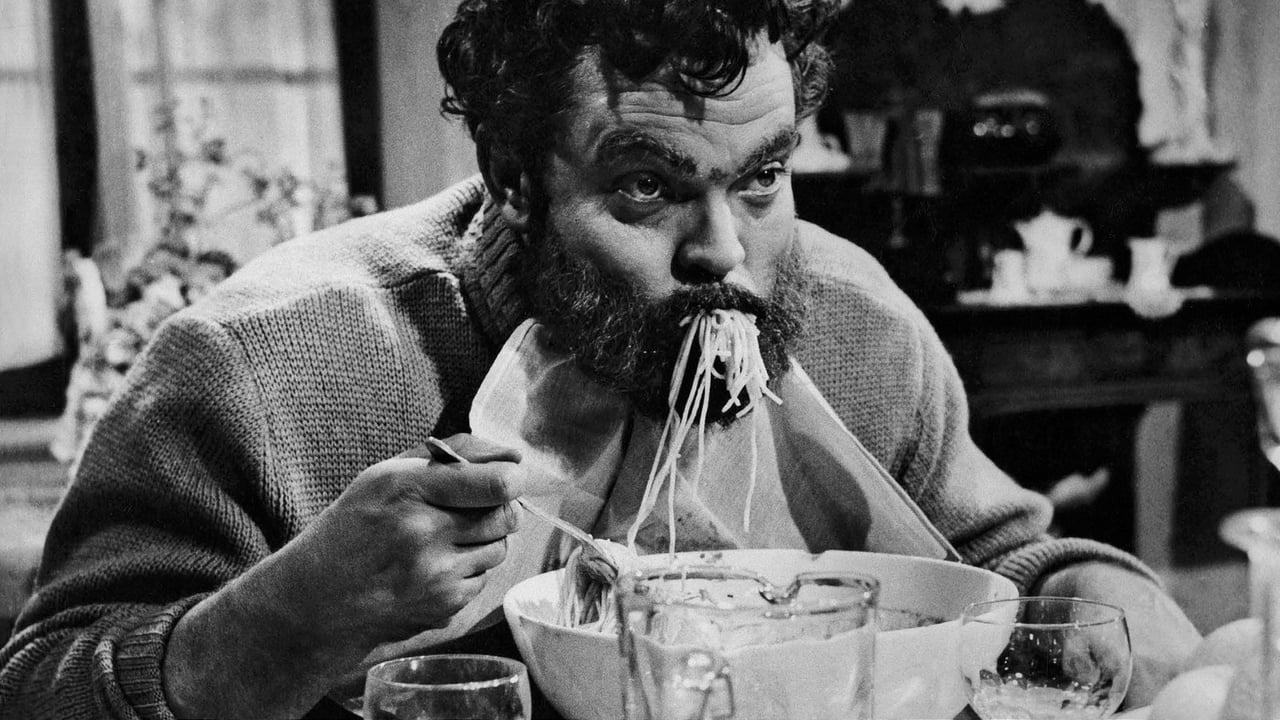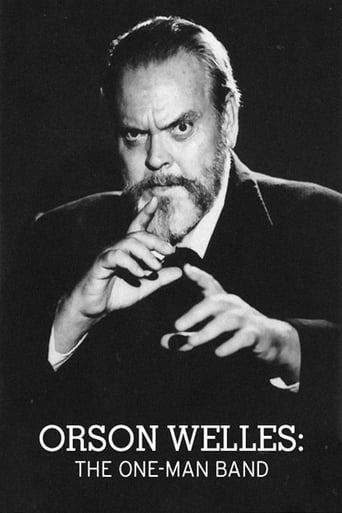

This is some clips of unfinished Orson Welles films along with some interview footage of him and his ex lover and some pretentious filler. This includes a fascinating scene from The Other Side of the Wind, some interesting bits from The Dreamers and The Deep, some Moby Dick monologues and some comedic nonsense that is like some weird old guy's home movies.Oja Kodar is engaging as she talks about her time with Orson, but she's apparently also been a major impediment to the finishing of The Other Side of the Wind, and one suspects that a lot of the intent of this film is to put Oja in front of the public, since she Welles was never able to make a star of her. (On the bright side, I think Netflix has managed to get the project of finishing the film going again; hopefully they'll finally do it!)While there are some terrific moments, the presentation is lacking and some of Welles' material is shockingly amateurish.
... View MoreGary Graver and Oja Kodar were Orson Welles' constant companions during the last years of his life. Graver was his photography director for American films and Kodar was his live in girlfriend. In One Man Band, the focus is usually on the films Oja performed in. The secondary message seems to be Oja wants fame and recognition because she was Welles' lover and wants to use him as a stepping stone to promote her own success. Shown is an extended promo for F for Fake where Oja is prancing about semi nude or in sexy clothes every minute of the ten minutes or so of the rejected trailer. The film in fact was a boring comparison of a famous art forger and Clifford Irving who faked Howard Hughes' biography. My main disappointment is that more of Welles' legendary unfinished film was not shown, The Other Side of the Wind. The scene shown is a short semi nude clip featuring Oja again. Gary Graver was said to have a complete working print of the movie, but his documentary featured little or nothing from it at all. A truckload of films are retrieved, but Oja claims to have just a few scenes. This is very hard for me to believe, indeed. A complete film from either Graver or Kadar kept separately from the negative stored in a vault in France seems to have vanished.
... View MoreOrson Welles fans, this may be the best you'll get in terms of 'lock-box' finished films from the prolific, perpetually f***ed over father of maverick-style cinema (i.e. few films made in Hollywood, with Europe his only safe place for his very independent ways as an actor/writer/director/producer/editor). Like an author who's smaller, in-the-vault kinds of works put together by an editor into one compilation, One Man Band, like the documentary It's All True, is a sort of collector's item in and of itself. Along with giving the fullest possible glimpses (as far as we Welles fans know) of the films as part of Welles's un-official scrapbook, there are some revelatory insights from his longtime companion Oja Kodar, and clips from a public interview in an auditorium (a very funny one) that shines some light on a couple of issues. The director here is the editor, assembling the pieces at times in the essay style of F for Fake (and this film is now included with it on the brilliantly packaged Criterion DVD), though not as frantic in style and purpose.Here we get something very special, in spurts, and even when the interest is a little more low-key than expected (though fun, the novelty isn't exceptional of Welles reading excerpts from Moby Dick and The Merchant of Venice), one can't look away. The best parts include the intact scenes from the Deep, London, the filmed excerpts of Merchant of Venice, the little moments of Welles's odd, hilarious imitations, and the one that still could be completed, the Other Side of the Wind. That last film is maybe the most fascinating film of the lot, as it goes even further with montage and experimental style than F for Fake. It's wild, it's rambling, and I could only get an idea of what was going on, but that's all I could've asked for anyway. The veneer of Welles's personality, as well, is stripped a bit away through Kodar's insights, how he was more of a modest man than the overwhelming, megalomaniac personality people made him out to be. At the end of the day he was, as the film makes clear without a shadow of doubt, one of the true poets of 20th century cinema, and like other controversial artists his major works were practically all censored, while the minor works barely left his traveling-alongside film cans.To see a filmmaker at work, at least in retrospective, can be many things, from dull, to over-indulgent, to really passing all of that and showing a man at work. While there isn't footage of Welles at work on a set like with Ingmar Bergman Makes a Movie or A.K., the footage here compensates for that. One can see through the little bits of film done, the ones that showed his determination to keep rolling along instead of getting stuck in the past, that it isn't too much of a surprise that he got a little sick of people tipping the hat to Citizen Kane and nothing else he did in his career. His story is one of the tragedies of the artist's world, though it's good to know that he never got too depressed to not quit at the magic and voices. It's a real treat.
... View MoreOrson Welles: The One-Man Band, which is one of many excellent extras on the Criterion Collection DVD edition of Welles' film F for Fake (Vérités et mensonges, 1974), is a 90-minute documentary, put together (co-directed) by Welles partner/companion Oja Kodar and filmmaker Vassili Silovic. It examines Welles' career primarily via a focus on his unfinished projects, and is of great interest to Welles fans for presenting (sometimes extended) clips of those unrealized films. Although this documentary is put together in the style of F for Fake, it's not nearly as successful artistically, which probably underscores what a genius Welles could be when he was in charge.The unfinished or lost works prominently featured include Moby Dick, The Merchant of Venice (1969), The Other Side of the Wind (1972), and a kind of surrealistic "biopic" that Welles was working on, set in London, called One Man Band. There is also a fascinating question and answer session with Welles filmed on a college campus, bits of a television show with him talking to various Muppets (it appears to be more of a talk show than something taken from The Muppet Show), a few instances of Welles performing magic tricks, and quite a few scenes filmed specifically for this documentary. The latter tend to have the best cinematography. The clips from unfinished films that Welles shot or supervised tend to not be properly processed. They need color correction; they need to be cleaned up, and so on.Just seeing the Welles film clips out of context like this tends to undermine their potential impact for me. For example, the surrealistic Merchant of Venice scenes and the bizarre sex scene from The Other Side of the Wind are both fascinating, but with improperly processed prints and with just snippets that should have arrived in a full film in the same vein, neither quite work, and in the context of this documentary, they tend to slow it down too much. The bits of Welles reading sections from Moby Dick at the camera in close-up and the brief scenes from an unrealized film called the Dreamers do not work at all for me. The snippets of One-Man Band are primarily interesting in that they amount to Welles doing his best Benny Hill impersonation.Although I was drawn to the documentary by seeing the unfinished clips, what ended up being the most significant aspect of The One Man Band for me was the exploration of Welles' difficult relationship with the film industry, his occasional bad luck (such as losing or having the negatives of Merchant of Venice stolen), his efforts to fund his projects, which tended to always surmount what he could arrange financing for, and his public comments, which mostly downplayed the unfinished works, and in which he presents himself both as a carefree, somewhat modest "artiste" and a deep pessimist. In some of these respects, Welles had a career similarity to other maverick outsider artists, such as Frank Zappa.Relatively simple shots, such as driving by the outside of the big Hollywood studios and the Director's Guild of America, have significant symbolic impact in this context, as we're seeing the "closed door" to Welles' creative ideals. There are aspects of Welles that I would have liked to see explored more in depth in this documentary, such as his visual artworks (both the works intended as ends in themselves and those intended as tools for film-making), but this is a fairly successful, if somewhat sad and disheartening look at a very unique talent.
... View More